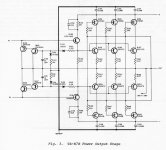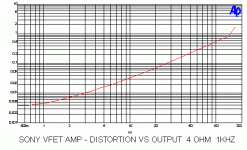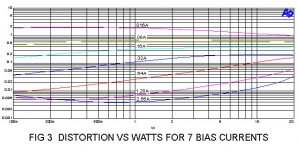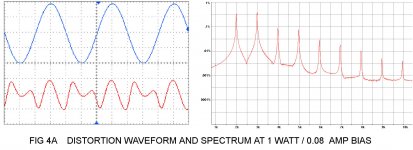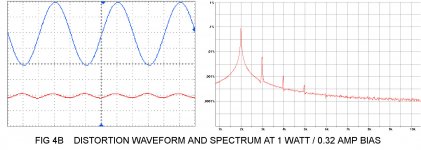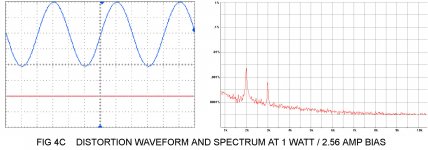Correction
While making a sally, I didn't remember a certain detail accurately of this very technical report from SONY about the TAN-8550. It was not 0.1%, but 1% THD, certainly H2 dominated in open loop, but at 75dB open loop gain and 100W into 8 Ohms.
What is very interesting is the fact that open loop THD is identical at 1kHz and 20kHz and also constant between 1 and 100W. The small signal open loop bandwidth was 35kHz, dominated by compensation. If these BW and gain figures are correct (they sound almost too good to be true), the GBP would therefore be 140 MHz at 35kHz. Very impressive in 1974 and still also nowadays ...
The first functional protos of the SONY V-FET amp were btw. already running in 1969 (At that time in housings looking like a TA-3120). It needed until 1974 to make the V-FET device or the LSI process fab they were produced in (almost) mass production proof.
I have an internal SONY technical report at hand, which shows THD spectra of a TAN-8550 with and without overall feedback applied. The open loop THD was less than 0.1%, far below the claimed 2% of the Pass design using the switch V-FETs. You can be sure, that three pairs 2SK60/2SJ18 pair at rank 58 was much better matched (at least at that time), than you could do with the last remaining stock of 2SK82/2SJ28 (which were made for switching applications !)
While making a sally, I didn't remember a certain detail accurately of this very technical report from SONY about the TAN-8550. It was not 0.1%, but 1% THD, certainly H2 dominated in open loop, but at 75dB open loop gain and 100W into 8 Ohms.
What is very interesting is the fact that open loop THD is identical at 1kHz and 20kHz and also constant between 1 and 100W. The small signal open loop bandwidth was 35kHz, dominated by compensation. If these BW and gain figures are correct (they sound almost too good to be true), the GBP would therefore be 140 MHz at 35kHz. Very impressive in 1974 and still also nowadays ...
The first functional protos of the SONY V-FET amp were btw. already running in 1969 (At that time in housings looking like a TA-3120). It needed until 1974 to make the V-FET device or the LSI process fab they were produced in (almost) mass production proof.
That disadvantage, which already exists for non bridged PP V-FET amps in a more mild form is btw. greatly reduced by running the V-FETs in cascode with bipolars (like SONY TA-N7B), as you also can read in official technical SONY literature. But this then wouldn't be an amp with a "pure" V-FET output stage anymore ...
You seem to be operating from some mis-information.
I will address some of your points later, but here is a schematic of the TA-N7
amplifier, showing that in fact the VFETs are being used to cascode the
Bipolar outputs, not the reverse. This is a bipolar amplifier in my opinion,
and any part would have served as the cascode - here it is simply convenient
that the VFETs are self biasing.
Attachments
.... We don't have a schematics of it so far ... and that's good, that nobody tries to clone it, burning even more V-FETs for a horrible 2% of distortion afte matching a hundred ...
You are conflating the performance of two entirely different amplifiers.
One, the published DIY project is a common-source amplifier in which the
VFETs are expected to provide both voltage and current gain.
The other, which was made for Sony and is more in keeping with Sony's
particular needs, is a Common Drain (follower) design.
As you should know, followers inherently contain their own feedback in the
form of degeneration with the load. They tend to measure a lot better
for that reason, and don't make for an apples-to-apples comparison.
The amplifier made specifically for Sony's 4 ohm AR1's does 0.6% thd at
100 watts into that load with 6 dB of feedback and has a bandwidth of -3dB
at 100 KHz. I believe that this is comparable to the measured performance
you quote. Attached is a curve.
Attachments
Complementary+bridge symmetry certainly helps canceling second order nonlinear effects of junction caps, but doesn't help a lot for the remaining symmetrical modulation of the group delay and such an effect can often be heard easily, even if no widely accepted easy measurement routines (or a large promoting group of people) exists for that.
This would be the kind of argument that would be more popular over in the Blowtorch thread.
I don't get excited by the symmetrical modulation of group delay in an
amplifier with 100 KHz bandwidth and little or no feedback.
Declaring the 0.5A idle current in e.g. a TA-8650 as being Class B strictly follows the definition of Douglas Self, that Class B is where the minimal (static) crossover distortion is. Above the associated bias point you get gm rise (often called gm doubling), below you get gm droop close to zero.
I do not accept a 0.5A bias as being Class B. I regard it as AB.
I recall that Douglas Self (who is a great bloke, BTW) is talking about bipolars.
When it comes to THD measurement, he is totally correct on the matter of
"optimal bias" as well as the proper ballast resistors to use to get the effect.
As to sound, there is a little more controversy - I have noted that higher
bias in bipolars still sounds better than "optimal" and this was how I biased
the Threshold "Stasis" amplifiers - they measured better at lower bias, but
they sounded better at higher bias.
With FETs, it is my considered opinion that (within rational limits) the higher
bias the better. All you have to do is build an output stage and measure
the distortion vs bias current and you will clearly see what I mean.
I attach some graphics of distortion vs bias for a push-pull follower FET
output stage:
Attachments
And I expected to get all kinds of negative criticism of almost all people here. Just like stirring up a hornet's nest and that's exactly, what I wanted to provokeThe massive reaction also showed to me, that some people were deeply hit in their unreflected believes.
It has been my friendly intention to respond to your provocative comments.
I appreciate the opportunity to get up on my soapbox and trot my erudition
out for the benefit of all.
Operated Common-Source with 18 dB of gain, I get about 3 nF effective input
capacitance.

Some passive preamps (maybe a few actives too) will be very unhappy...
It has been my friendly intention to respond to your provocative comments.
I appreciate the opportunity to get up on my soapbox and trot my erudition
out for the benefit of all.

Thank you Papa…..you have removed most opportunity for confusion amongst even we lesser mortals!
Some passive preamps (maybe a few actives too)
will be very unhappy...
The preamps will be happy regardless. They don't know Satie from a Rice
Krispies ad. Worst case for the listener with a 10K pot (mid position) will be
20 KHz bandwidth. Of course you can buffer it, as I have with the SIT-1 and
SIT-2 as options, and the B1 does that job also.
You can lower the gain, as the bandwidth for a fixed source impedance is
roughly inversely proportional to the gain.
I have noticed, though, that hardly anyone is using the on board buffers
of my SIT amps, to the extent that I consider removing them and using the
input connector for balanced input instead.
...Worst case for the listener with a 10K pot (mid position) will be 20 KHz bandwidth...

This is more what I was getting at Mr. Pass...though some would perceive it as having a smoother top-end but in fact would be due to bandwidth drop-off. I'd say 5k would be a better choice as mid-position will be where listening would be on some materials, given the lower than most power amp voltage gain.
Doable without buffers so I'd take this road...
I'd say 5k would be a better choice as mid-position will be where listening would be on some materials, given the lower than most power amp voltage gain.
A 10K pot would ordinarily give you mid-position source impedance of 2
parallel 5K resistors - 2.5K. This is worst case.
I do not accept a 0.5A bias as being Class B. I regard it as AB.
I recall that Douglas Self (who is a great bloke, BTW) is talking about bipolars.
When it comes to THD measurement, he is totally correct on the matter of
"optimal bias" as well as the proper ballast resistors to use to get the effect.
As to sound, there is a little more controversy - I have noted that higher
bias in bipolars still sounds better than "optimal" and this was how I biased
the Threshold "Stasis" amplifiers - they measured better at lower bias, but
they sounded better at higher bias.
With FETs, it is my considered opinion that (within rational limits) the higher
bias the better. All you have to do is build an output stage and measure
the distortion vs bias current and you will clearly see what I mean.
I attach some graphics of distortion vs bias for a push-pull follower FET
output stage:

IMO 0.5A for 3 devices 2SK60/2SJ18 in parallel or two 2SK77 PP can be considered Class B as well as 35mA could be considered Class B for a bipolar stage (with the right choice of emitter resistors).
In your reasoning that the bias can't be high enough, you were absolutely right, if you would consider the output stage gm being constant vs. bias current. Unfortunately gm goes up with bias increased and this increases feedback in the output stage intrinsically reducing distortion further.
If you would normalize your THD for your example FET stage to intrinisc gm (calculate back to a virtual open loop), the distortion would not drop anymore above a certain bias point and that could mean that any other kind of (local) feedback and/or feed forward applied to the OPS could also be used to reduce the non linearity in the very same way as you do by increasing the bias.
I don't see, that the rise of gm vs. bias is really the most perfect distortion reduction mechanism one could apply here. It is brute force indeed, and it is thus as simplistic as one could imagine, but there is certainly healthy life below the area, where classic Class A operation is. The complementary SONY V-FETs give opportunities here (in the direction of Class B) and IMO their "raison d'être" is not in Class A or deep Class AB. This was btw. also the opinion of the SONY engineers, who created them (clearly written in SONY technical documentations).
Without having much real world hands on experience with the bias point game regarding V-FETs I can only say, that the OPS gain vs. output DC voltage, which Douglas Self uses for judging over-bias or under-bias is certainly a very informative means, showing probably a quite different picture than the traditional THD vs. Power you use. And this can be definitely also measured, not only simulated (as Douglas Self mostly does). From my perspective both representations have their right to exist, even, if both lead to completey different interpretations, where an optimum bias level could be.
At the end the ears tell the final truth and again: Classic V-FET amps sound excellent, even while only operating (close to) Class B.
Regarding Class B and standard bipolar EF stages (and also for vertical MOSFETs), I can only say, that thermal and dynamic distortion effects completely kill the theoretical advantage of this operation mode.
And yes my experience is also, that slightly overbiased bipolar Class B stages sound better, but that could also be because of the pronounced switching distortions at lower bias levels and the less pronounced modulation of bias due to thermal effects at "over bias". As I know, at least complementary V-FETs with their very smooth crossover region don't show switching distortion in Class (A)B, nor don't they show the dramatic thermal dependency of bipolars of vertical MOSFETs.
So the commonly accepted rule to avoid Class B if possible doesn't necessarily apply to complementary V-FETs. I would say, that the exception proves the rule here.
The TA-N7B is IMO not a full-blooded V-FET OPS amp, because the output stage basically is a Class (A)B bipolar EF stage, cascoded by V-FETs, so its behavior is mostly dominated by the bipolars. That's all I meant about that and I didn't confuse this at all (I can draw you a TA-N7B schematics by memory, but my English is a little limited, so some of my statements may have been misunderstood).
Interestingly the cascode with V-FETs let the smallish bipolar outputs keep their junction temperature rather constant and due to their enormous speed (ft=200MHz), one could say, that here Class (A)B really works with bipolars for the very first time.
This is probably the reason, why many consider the TA-N7B being one of the best sounding classic amplifiers. Here the amp doesn't sound good because the V-FETs dominate the sound, they only give the opportunity for the bipolars and the rest of the amp performing much better.
Last edited:
This would be the kind of argument that would be more popular over in the Blowtorch thread.
I don't get excited by the symmetrical modulation of group delay in an
amplifier with 100 KHz bandwidth and little or no feedback.

This is exactly the thing I originally wanted to criticize !
Many statements within this thread alone tell me, that Nelson Pass amplifier designs discussed here in the forum don't care much about nonlinearity of capacitances with associated time constants near or within the audio range. It is also said, that people even tend to like the sound of this ! I could also tell you that many people tend to like the sound of MP3.
If my warning may only be accepted in the Blowtorch thread doesn't mean that it is wrong or esoteric at all !
There are a few very well accepted audio and almonst all general analog designers, who are very careful about, what is classically referred to as "Differential Phase Distortion". This is a very well researched item in analog video for several decades, only the audio guild tends to ignore this and seems to think, that there is a kind of magic sonic barrier below 20kHz, which eliminates all kind of that stuff.
The fact, that loudspeakers are much worse in this respect than amplifiers and these are much worse than a jittery Audio DAC, doesn't mean that their impact is in the very same order, because the nature of the underlying sources is pretty different and gets more unnatural the more closer you get to the DAC.
Unfortunately many of the more recent (published) Nelson Pass amplifier designs shout out loud about this ignorance. And that was the reasoning behind my statement, that the (unpublished) topology of the 40th anniversary V-FET monster may tell us the very same story. And this led me to the provocative claim, that the good old TA-8650 may eat Nelson Pass' V-FET monster for lunch.
What was the impedance driving the V-FETs in this non (overall) feedback amplifier again ? I still don't know.
Why don't we find an opportunity to hear the SONY V-FET monster against a few selected (and refurbished) classic SONY V-FET amps ?
Btw.: Did you all know, that the good old feedback tends to reduce these effects ? Did you all read Bruno Putzeys' article and follow up about the "F word" in Linear Audio ?
Last edited:
you're having teenage attitude , on verge of bullying
Is this the only answer, which comes into your mind ?
I'm by far in a way too weak position to bully anybody here.
Does the moon really care when dogs bark at it ?
Attitude is a difficult thing to maintain, if you need to defend yourself against everybody in a foreign language ...
I only try to break up some strongly crusted beliefs here, hoping at least a few people start to think about these things and come with their own audio designs instead of repeating, what others say or think.
If you want to disprove me, please do it, I gave you enough material for that. Then lets start a real discussion.
Before again some misinterpretations come up:As I know, at least complementary V-FETs with their very smooth crossover region don't show switching distortion in Class (A)B, nor don't they show the dramatic thermal dependency of bipolars of vertical MOSFETs.
" ... show the dramatic thermal dependencies bipolars or vertical MOSFETs generally exhibit."
you invented existence of strongly crusted beliefs here ; primary purpose of this forum is to courage different thinking and trying whatever you want to try
regarding language - English or German aren't my native too
I don't want to disprove you - that's not how I'm used to function ; I can say what I think , you can say what you think , but in proper and civilized manner ;then you're free to think whatever you want , but don't harass me to think same as you .
you did opposite of that in few posts , and in other few you didn't wrote anything to back up what you wrote in previous ones
as I told you - take that same Sony VFet schematic , made it properly and that amp will wipe the floor with your precious original one .
so , just because wiping the floor with anything isn't my cup of tea ...... and pretty much same case with majority of residents here , please behave
regarding language - English or German aren't my native too
I don't want to disprove you - that's not how I'm used to function ; I can say what I think , you can say what you think , but in proper and civilized manner ;then you're free to think whatever you want , but don't harass me to think same as you .
you did opposite of that in few posts , and in other few you didn't wrote anything to back up what you wrote in previous ones
as I told you - take that same Sony VFet schematic , made it properly and that amp will wipe the floor with your precious original one .
so , just because wiping the floor with anything isn't my cup of tea ...... and pretty much same case with majority of residents here , please behave
- Status
- This old topic is closed. If you want to reopen this topic, contact a moderator using the "Report Post" button.
- Home
- Amplifiers
- Pass Labs
- Sony VFET Amps
